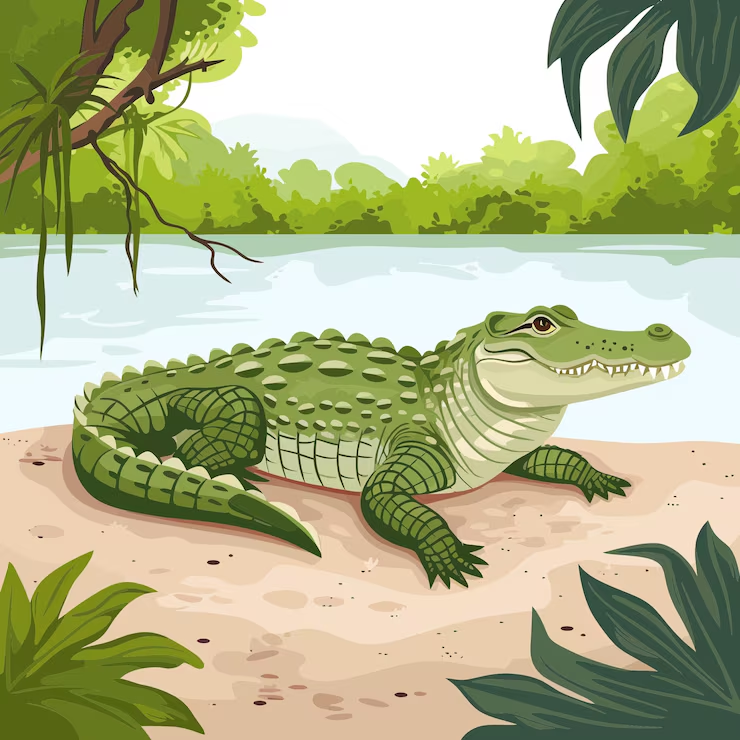Answers For VOL 6 Test 6 - Crocodile Study
Answers and detail explain for VOL 6 Test 6 - Crocodile Study
1.
satellite
2.
radio
3.
signal
4.
navigate
5.
people
6.
helicopter
7.
head
8.
direct
9.
sun
10.
birds
Explain
VOL 6 Test 6 - Crocodile Study

0:00
0:00
Presenter: Hello, everybody. I've just arrived back from my field trip, and professor Martin has asked me to tell you about it today in our research forum. As many of you know already, my dissertation relates to crocodile behavior. My specialty is the saltwater crocodile, which is much larger than the freshwater crocodile. I've just come back from the Northern Territory, where I've been part of a groundbreaking study observing crocodile movements.
1It's not the only time crocodile movements have been followed, but this study is unique because we tracked crocodiles using a satellite. Up until now, 2studies like this one have only been able to track crocodile movements using radio. 3Not only was this method more stressful for the animal, which had to be caught several times, but it was also not very reliable, as the signal was often lost. So, you might be wondering why we chose to track crocodiles. Well, crocodile attacks on people and livestock are rare, but when they do happen, the government believes that the problem crocodile should be relocated rather than killed.
But can we be sure that the crocodile won't simply return to the place where it came from? So, we designed a study to try to answer these questions. We wanted to establish, firstly, how far crocodiles can travel over a period of time. 4The second thing that we wanted to know was how easy is it for crocodiles to navigate. Could they find their own way home again if they were moved to another location?
Of course, the biggest challenge when observing crocodiles is that they are very secretive animals. 5They stay well away from people if they can, which makes them really difficult to follow.
I'll give you some information about the design of the study now. There were three crocodiles in our study, all from the Northern Territory, and measuring between three and four and a half meters in length. 6The crocodiles were captured, measured and tagged, and then taken by helicopter to new locations up to 400 kilometers away from where they were found.
We were then able to use the tracking data to monitor their movements. 7We used a specially designed transmitter which we attached to each animal's head. The transmitter collected the data and relayed it back to us. The results of our study were quite astounding. After they were released, each crocodile remained in the release site for some weeks, making random movements around the site each day.
But then, 8they each swam home, traveling by the most direct route. These crocodiles showed remarkable navigational skills and stamina to swim such long voyages. So, what conclusions did we draw from this? Well, we proved that crocodiles are clearly capable of making marathon swims to find their way home. This meant that the current policy should be reconsidered.
You might be wondering how the crocodiles managed to get home. 9We concluded that they used factors such as sight and smell, as well as their position to the sun to point their way. 10It's a little known fact that crocodiles are more closely related to birds than they are to any other reptile, so we believe it's possible that they use the same system to negotiate long journeys. Now that the study has been completed...
Questions 1-10
Complete the notes below. Write ONE WORD ONLY for each answer.
Background
-
Type of crocodile studied: crocodiles found in salt water
-
Location of study: Northern Territory, Australia
-
Significance of study: unique because it was the first time a 1 (satellite) had been used to track crocodiles
Previous studies:
-
Done using 2 (radio)
-
Stressful method, also unreliable due to loss of the 3 (signal)
Reasons for study:
-
The management of crocodiles by the government may not be effective
Research questions:
-
How far can crocodiles travel?
-
How easily can crocodiles 4 (navigate) ?
Challenge:
-
Crocodiles are difficult to observe because they avoid 5 (people)
Details of study:
-
Number of crocodiles involved: three
-
Method: crocodiles were measured and Tagged hen relocated using a 6 (helicopter)
-
Monitoring: scientists got data from a transmitter located on the crocodiles 7 (head)
Results of study:
-
Each crocodile first stayed at the site for a few weeks, moving in a random way.
-
Then took the most 8 (direct) way home
Conclusions:
-
A change in policy is needed
-
When travelling long distances, crocodiles may use
-
Their own senses and the position of the 9 (sun)
-
A similar system to 10 (birds)
-
![[Forecast Q2-2025] - Biology lecture](https://static.helik.app/reading/8fd3d7d2-ccf9-47a3-8920-2e7a3b0d6607)
![[Forecast Q2-2025] - Living in the City](https://static.helik.app/reading/1a60bcf3-f3a7-4e9b-97a2-94d156a0de3b)
![[Forecast Q2-2025] - Student Union](https://static.helik.app/reading/fb443123-8c1d-447e-8c79-5a01650f4754)
![[Forecast Q2-2025] - Fruit-picking Job in an Orchard](https://static.helik.app/reading/e1968346-6c55-44ae-b8d3-f6a4fb7207b9)
![[Forecast Q2-2025] - University Crime Prevention](https://static.helik.app/reading/bdda593e-16d6-4c72-8a12-b116e917b27c)
![[Forecast Q2-2025] - Business Course](https://static.helik.app/reading/3308e282-99a6-4bcb-9d22-0b488701d968)
![[C20T1] - Choosing a restaurant](https://static.helik.app/reading/e9b21123-c43c-42fb-88b7-5d0be3a37e03)
![[YouPass Collect] - Car Club Scheme](https://static.helik.app/reading/6a749ba0-4cde-47fe-8260-f65b0599c3bf)